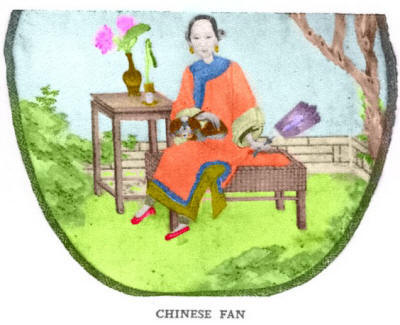
1
A Brief History of
the Chinese Imperial Dog
Written by Karen Christensen© of
Zhen Yi Chinese Imperial
Dog
The ancestors of our Chinese Imperial Dog originated in
the Imperial Palace Of China. The Chinese Imperial Dog
was called Imperial, Hah-Pah, and the solid colored
imperials were called Chin Ssu Ha-Pah in the Chinese
Imperial Palace. In early English books they are called
Imperial or “Pekinese Type” when they didn’t know what
to call them. The Imperial was always a separate dog
from the Pekinese, Shih Tzu and Lhasa Apso. They were
being bred along side them in the very early days but
they were not the same dog. The Shih Tzu came much
later.2 The Shih Tzu Kou or Liondog, as the early
Imperials were called, were bred in the likeness of the
Buddhist perception of the lion because when Buddha came
to earth from heaven he rode on a lion. Therefore, the Imperials were
also believed to be holy or tribute dogs and were highly
prized. When an Imperial became too large then it was
put to death as it was highly undesirable. As you can
see from this antique Chinese fan that the Imperial was
a small dog indeed.1
heaven he rode on a lion. Therefore, the Imperials were
also believed to be holy or tribute dogs and were highly
prized. When an Imperial became too large then it was
put to death as it was highly undesirable. As you can
see from this antique Chinese fan that the Imperial was
a small dog indeed.1
In later years these larger Imperials were called a Shih
Tzu. An old tapestry picturing an Imperial, Shih Tzu and
a Pekinese was found recently dating to before the time
of Christ. You can see the complete difference of the
dogs in this tapestry. This puts to death a rumor that
an Imperial is a Shih Tzu and that a Shih Tzu is a mix
between a Lhasa and a Pekinese. The Shih Tzu, Pekinese
and Imperial have been completely separate breeds of
dogs for more that 2000 years. The early ancestors of
the Imperial were given to the emperors of the Manchu
dynasty of China as gifts of great honor and were only
allowed to be owned by the emperors. In China the dogs
became little temple dogs and were kept in the palace
and carefully guarded and cared for by the court
eunuchs. As the lion dogs were the property of the Royal
family, they were not widely known outside the Imperial
Palace and it is said that anyone unlawfully owning one
was sentenced to death. However, it is thought that
puppies which did not meet the Dowager Empress’s high
standards, were secretly sold by the eunuchs to the
nobility outside the palace. The Dowager Empress Tzu-Hsi
was greatly interested in dogs and during her reign she
was personally concerned with their breeding and
welfare. They were bred to be loyal companions, bed
warmers and would lie across the feet of the Emperor and
Empress while taking would take care of court business
to keep their feet warm. She would keep a few Imperials
and Shih Tzu around her at all times. At one time it was
the fashion for the dogs to be carried in their kimono
sleeves.2
After the death of the Dowager Empress in 1908, the
breeding of the dogs was no longer important. The young Emperor and Empress were not
interested in the dogs and some were given as gifts to
noblewomen and men in England and the Netherlands.3 This
is how the Imperial was introduced to the west. In 1938
an individual standard was set for the Shih Tzu. At the
time the dog fanciers did not know what to do with the
Imperials so they lumped them together in with the
Shih Tzu. In the United States, fanciers obtained the
first Shih Tzu in the late 1930’s and they gained even
more popularity in the 1960’s with many imports coming
from England and Europe.
Our Chinese Imperial Dogs went to the Netherlands and
Australia and were kept pure bred and small.4 In the
1960’s a small few breeders brought them to the United
States. These breeders fought hard to get them
recognized but in their ignorance the AKC would only
classify our lovely Chinese Imperials as Shih Tzu.5
This is how many of the imperials became mixed with the
Shih Tzu. Now the dedicated breeders of the Chinese
Imperial Dog are fighting just as hard to get them
recognized again. These breeders myself included have
been breeding the Shih Tzu out of our imperials so as to
have again the purity of the Chinese Imperial. We have
been quite successful so far.
The Chinese Imperial dog was first accepted as it's own
breed separate from the
Shih Tzu by the NCA as of March 2005 and by the CPR,
UABR, and the NKC in
2006. The Chinese Imperial Dog is also internationally
recognized by the IPDBA.
A breed club has been formed to support this new breed
and is dedicated to
promoting and preserving this wonderful little dog.
#1Chinese Fans with the Chinese Imperial
Dog found in Dogs of China and Japan in Nature and Art
#2Dogs Of China And Japan In Nature And Art V. W. F.
Collier
# 3This Is The Shih Tzu Allan Easton
#4 First Account from Jane Seng
# 5First Accounts from Ron Finney and Jane Seng
Copyright© 2007 Karen Christensen All rights reserved.